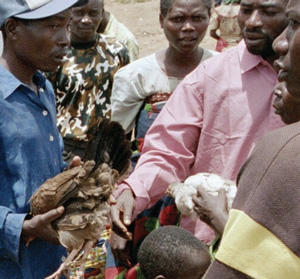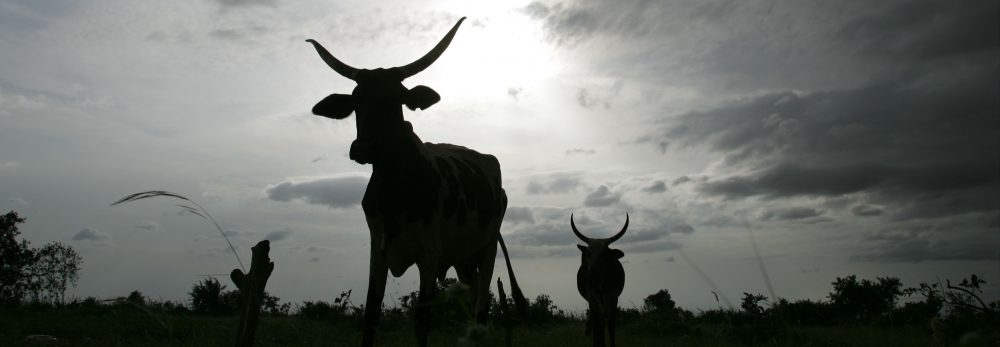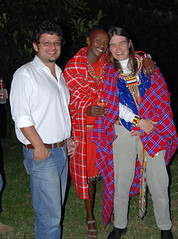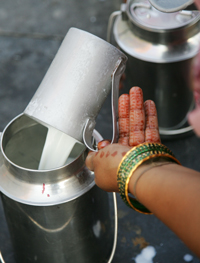The Scientific and Technical Review features ‘participatory epidemiology’ – a customer-oriented approach to disease control and surveillance that is being successfully applied in the battle against bird flu in Indonesia.
The latest issue of the World Animal Health Organization’s (OIE) Scientific and Technical Review contains 21 articles submitted by experts from all over the world describing different animal disease surveillance, control and elimination strategies, including an article on ‘participatory epidemiology’ for the control of deadly animal diseases.
 Participatory epidemiologists rely on local knowledge to gather data on how disease is spreading, kept in circulation, and which diseases have most impact on livelihoods, from the perspectives of those affected. This ‘customer-oriented’ approach is throwing up surprises and proving to be working well for a variety of diseases that have big implications for animal health and veterinary public health worldwide.
Participatory epidemiologists rely on local knowledge to gather data on how disease is spreading, kept in circulation, and which diseases have most impact on livelihoods, from the perspectives of those affected. This ‘customer-oriented’ approach is throwing up surprises and proving to be working well for a variety of diseases that have big implications for animal health and veterinary public health worldwide.
The authors of the paper, ‘Participatory epidemiology in disease surveillance and research’, from the International Livestock Research Institute (ILRI), Food and Agriculture Organization of the United Nations (FAO), Ministry of Agriculture, Jakarta and United States Agency for International Development (USAID), summarise current field applications of participatory epidemiology and highlight lessons learned, future challenges and possible new areas for research. They argue that with the increasing international focus on emerging and re-emerging zoonotic diseases (animal to human transmitted), there is an urgent need for better integration of veterinary and public health surveillance programmes.
New approaches to new and old diseases
Traditionally, veterinary authorities and scientists approach disease outbreaks by making expert diagnoses and devising control solutions, with little involvement or consultation with the farmers affected. Participatory epidemiologists work differently and livestock keepers play a central role as key informants.
ILRI’s participatory epidemiologist, Christine Jost explains, ‘Participatory epidemiologists understand the importance of tapping into local knowledge and encouraging the participation of people affected. By involving local livestock keepers, we can gather valuable data on how disease is spreading and kept in circulation.
‘In poor countries there is often a lack of detailed information on disease outbreaks and prevalence. This is largely due to a lack of veterinary infrastructure, and also because there are typically many remote and isolated communities that are hard to reach. Even when there is some infrastructure in place, many authorities assume that farmers will come to their offices to report diseases. However, farmers would have to travel long distances to reach veterinary posts and incur significant costs when reporting disease problems. Thus it is very difficult to assess the real disease situation and the impacts of animal diseases on livelihoods.’
‘We go out into local communities and we talk to villagers. Local livestock keepers are critical in helping us establish livestock disease prevalence, symptoms, recent outbreaks, and also the impacts of different animal diseases from their perspectives. This approach is very much community centred and ‘customer-oriented’, says Jost.
Country experiences
This customer-oriented approach has thrown up some surprises which and reinforced the importance of actively involving local livestock keepers in disease control and surveillance plans and assessing disease priorities.
In Pakistan, authorities had previously thought that Foot and Mouth disease had the most important economic impact on farmers. However, participatory epidemiologists found that most farmers could cope with production losses from Foot and Mouth disease, but they could not cope with the impact of haemorrhagic septicaemia. These farmers took a more holistic view and considered risks and coping mechanisms, alongside economic impacts, when they prioritised diseases. This resulted in a rethinking of how diseases were prioritised by authorities.
In Indonesia, participatory epidemiologists, highlighted the true extent of bird flu. The avian influenza programme was first implemented in Indonesia in 2006 as a pilot programme and this has been rapidly expanded. When the programme was initiated, the extent of bird flu infection was not known. However, participatory epidemiologists found that bird flu was circulating unimpeded in backyard poultry, and within the first 12 months of operation, 800 disease events were detected. The large number of outbreaks detected overwhelmed the response capacity of the district animal health infrastructure, and led to recognition of the need to re-evaluate the national control strategy.
In Kenya, ILRI participatory epidemiologist, Jeff Mariner, led a multi-disciplinary team of participatory epidemiologists, economists and social scientists who assessed the impacts of the recent Rift Valley fever outbreak (a total of 684 human cases including 155 deaths of RVF were reported in Kenya between November 2006 and March 2007). This United States Agency for International Development (USAID) funded project generated some surprising results. One of the key findings was the importance of monitoring livestock owners’ local observations in early warning systems for preventing future outbreaks of the disease. The team is now about to start a follow-on project, contracted by FAO with USAID funds, to apply those lessons to Tanzania, and to develop guidelines for government decision-makers in Kenya and Tanzania so that they can have policies that more effectively take into consideration livestock owners’ knowledge for Rift Valley Fever prevention and control.
The future
While veterinary participatory epidemiology approaches are proving to be working well for various diseases, the authors of the Review paper argue that with the increasing international focus on emerging and re-emerging zoonoses, there is a need for better integration of animal health and public health surveillance programmes.
Traditionally, there is little collaboration or sharing of information between the veterinary and public health sectors. However, in Indonesia, the two sectors are now working together and applying participatory approaches in the fight against bird flu. Veterinary participatory disease surveillance is being used to target participatory public health surveillance to the most at-risk human populations – those whose poultry are experiencing outbreaks of active disease.
ILRI is also involved in another project in Indonesia, which commenced in August 2007. This is being funded by USAID.
According to Jeff Mariner, ‘This project focuses on different applications of participatory epidemiology methods in research.
‘We are testing the impact of alternative avian influenza disease control strategies on disease incidence, as well as testing the feasibility of various control options from an operational and livelihoods viewpoint’ says Mariner.
Mariner, Jost and colleagues are also involved in a pan-African project – Participatory Approaches to Disease Surveillance in Africa (PADSA) – which began in October 2007. The project, scheduled to be completed in two years, involves research to evaluate and apply participatory risk-based approaches to bird flu surveillance and to document lessons learned.
Need for veterinary and public health to work more closely together
The authors of the Review paper argue for the need for veterinary and public health to work more closely together and to apply participatory approaches. They make the following recommendations:
- Expand the field of participatory public health through active research to identify public health surveillance and response gaps that can be filled using participatory methods.
- Provide advocacy for policies that recognise veterinary services as integral to public health.
- Devise innovative ways to integrate participatory disease surveillance workers and participatory public health practitioners in the field; and
- Create effective models for integrating public health and veterinary surveillance, including the development of unified ‘public health’ databases.
One step forward has been the establishment of the Participatory Epidemiology Network for Animal and Public Health. Its purpose is to advance the science of participatory epidemiology through targeted research, capacity building, policy enhancement and practitioner education. The network is coordinated by ILRI and includes FAO, OIE, AU-IBAR, and nongovernmental organisations experienced in participatory epidemiology methods.
Article citation
Article reference: CC Jost, JC Mariner, PL Roeder, E Sawitri and GJ Macgregor-Skinner (2007). Participatory epidemiology in disease surveillance and research. Scientific and Technical Review. Volume 26 No 3. The Office International des Epizooties (OIE). pp 537-547. http://www.oie.int/doc/ged/D4693.PDF
Linked articles
Controlling bird flu in Indonesia through local knowledge ILRI news April 2007: /archives/494
Further information:
Christine JostVeterinary Epidermiologist
International Livestock Research Institute (ILRI)
Nairobi, Kenya
Email: c.jost@cgiar.org
Telephone: +254 (20) 422 3435 OR Jeff Mariner
Veterinary Epidemiologist
International Livestock Research Institute (ILRI)
Nairobi, Kenya
Email@ j.mariner@cgiar.org
Telephone: +254 (20) 422 3432

 Dramatic losses of plant diversity, including fodders and forages that feed livestock, are one of the greatest challenges facing sustainable development today. Soaring human populations are eroding the world’s plant genetic diversity and other natural resources. Increasing demands for human food, along with urbanization, pollution and land degradation, are squeezing out hardy fodder and forage plants that allow half a billion poor people to keep livestock. These fodders and forages are vital today. In future, they may become the only way poor livestock keepers are able to adapt to climate and other changes.
Dramatic losses of plant diversity, including fodders and forages that feed livestock, are one of the greatest challenges facing sustainable development today. Soaring human populations are eroding the world’s plant genetic diversity and other natural resources. Increasing demands for human food, along with urbanization, pollution and land degradation, are squeezing out hardy fodder and forage plants that allow half a billion poor people to keep livestock. These fodders and forages are vital today. In future, they may become the only way poor livestock keepers are able to adapt to climate and other changes. 





